|
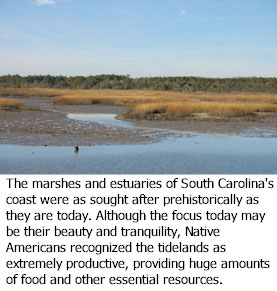 About 4,000
B.P. (around 2,000 B.C.)
the environment began to
change along the South
Carolina coast. Sea levels
rose from a low of about 12
feet below their current
levels to almost modern
levels. This increase in sea
level created the
marshes, inlets, and tidal
areas that today make the
coast such an
environmentally rich and
productive area. This
ecological change also
brought about significant
changes in the way
prehistoric South
Carolinians, or
Native Americans,
interacted with their
environment. About 4,000
B.P. (around 2,000 B.C.)
the environment began to
change along the South
Carolina coast. Sea levels
rose from a low of about 12
feet below their current
levels to almost modern
levels. This increase in sea
level created the
marshes, inlets, and tidal
areas that today make the
coast such an
environmentally rich and
productive area. This
ecological change also
brought about significant
changes in the way
prehistoric South
Carolinians, or
Native Americans,
interacted with their
environment.
The Native American groups
that had been seasonally
moving from location to
location, hunting deer and
collecting nuts, began to
understand that there was a
great diversity and
abundance of foods on the
coast. So many foods to
choose from in one place
provided another option –
nearly permanent
settlements.
These people began to
collect shellfish and trap
fish using nets. They
supplemented their diet by
collecting occasional marsh
visitors, such as marsh
rabbits, turtles, opossums,
snakes, and even alligator.
They still hunted deer and
collected hickory nuts.
However, by adding a variety
of other foods, their diet
improved and they were able
to live in one place
longer. This reduced the
amount of time they had to
move from one location to
another. This is what
archaeologists call “sedentism.”
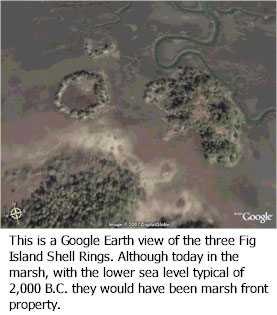 Shell Rings and Shell
Middens Shell Rings and Shell
Middens
An
unusual type of
archaeological site
developed during this period
–
doughnut-shaped piles of
shell that
archaeologists call “shell
rings.” Although these
rings are found in different
sizes, they average about
160 feet in diameter, 4 to 5
feet in height, and have a
width at their base of about
45 feet. There are
several theories about
the function of these sites,
but what we know is that
they contain a huge
assortment of floral and
faunal remains – showing us
the varied diet of the
people who lived on or
around them.
Because these people existed
so long ago, archaeologists
cannot associate them with
any modern Native American
tribal groups. Instead,
these Native Americans are
known as the “Thom’s Creek”
people. Thom’s Creek is
also the name of the type of
pottery these people made.
Thom’s Creek pottery has a
sandy texture and is often
decorated with various
punctuations. Found along
the South Carolina coast, it
is associated with the shell
rings, and dates from about
2,000 B.C. to 500 B.C. It
is one of the earliest types
of pottery made by the
Native Americans in South
Carolina. While the Thom’s Creek
people are best known for
their shell rings, these
were not the only sites they
left behind.
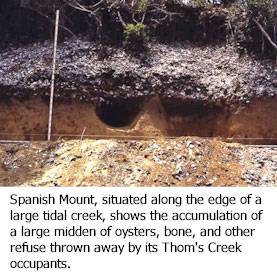 In
addition to shell rings,
there are also huge
shell mounds or middens
such as
Spanish Mount on Edisto
Island (Charleston County)
which several USC
archaeological field schools
have studied. Probably the
most common Thom’s Creek
sites are actually small
accumulations of shells and
refuse (the garbage thrown
away by the Thom’s Creek
people), and they have
received very little study.
Recently, however, with the
cooperation of Carolina Park
Associates, archaeologists
have been given a unique
opportunity to examine one
such site. In
addition to shell rings,
there are also huge
shell mounds or middens
such as
Spanish Mount on Edisto
Island (Charleston County)
which several USC
archaeological field schools
have studied. Probably the
most common Thom’s Creek
sites are actually small
accumulations of shells and
refuse (the garbage thrown
away by the Thom’s Creek
people), and they have
received very little study.
Recently, however, with the
cooperation of Carolina Park
Associates, archaeologists
have been given a unique
opportunity to examine one
such site.
Carolina Park Associates
and 38CH1693
Known as
38CH1693, this site was
discovered in 2003, at the
corner of Airport Road and
US 17,
during routine
archaeological surveys.
The site was slated for
additional investigation
prior to development. Over
several weeks during the
summer of 2006,
archaeologists with the
Columbia, South Carolina
based Chicora Foundation,
conducted
excavations, made maps, took
samples, and collected
artifacts from this
site.
|
The initial step
in the
archaeological
excavation was
the creation of
an accurate grid
to ensure that
all excavation
units - and the
artifacts they
exposed - could
be precisely
plotted.
Although the
excavation used
shovels, each
level was
precisely noted
and all soil was
either screened
through ¼ mesh
or was
waterscreened
through 1/8-inch
screen. The
water screening
allowed for
recovery of very
small fish bones
and even fish
scales. After
the excavation
all units were
carefully
cleaned, then
photographed and
mapped. |
Research indicates that the
site was situated on a relic
Pleistocene dune ridge.
Located nearby were not only
upland resources, such as
deer and hickory nuts (a
favorite – and nutritious --
food source for Native
Americans), but also springs
and marshes. The springs
supplied fresh drinking
water, while the saltwater
marshes provided fish and
shellfish to eat. Within
just an hour’s walk from
38CH1693, the Thom’s Creek
people could find a variety
of foods – making this an
ideal area to live.
Archaeologists found that
the site was not a shell
midden; instead, it
consisted of several areas
where the inhabitants had
dug pits in which to steam
oysters and other shellfish.
Thus, while there were no
layers of shell, there were
individual pits (what
archaeologists call
“features”). These
features were especially
important because they
helped preserve the food
remains. Recovered from
these features were the
shells of hickory nuts eaten
and discarded into the fire,
as well as animal bones, and
fragments of shellfish. The
features even preserved
pollen and
phytoliths – all of
which were studied by the
Chicora team.
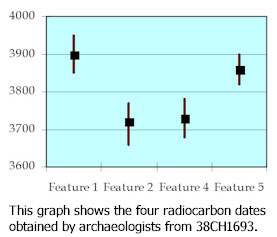 What Was Learned? What Was Learned?
One of the most important
findings was the age of the
site. Using
radiocarbon dating of
the hickory nutshells,
Chicora determined that
38CH1693 dates from
about 1,700 B.C. to 2,000
B.C. In fact, two of the
four dates place occupation
at almost precisely the same
time – 2,135 B.C.
This is important since it
reveals that the site,
occupied during the middle
of the Thom’s Creek period,
was used only briefly.
38CH1693 is giving us a
brief snapshot of life at a
Thom’s Creek site.
Other information, however,
is not so simple to
interpret. For example, the
animal bones suggest the
site was occupied
seasonally, perhaps during
the spring through late
summer or fall. This is
suggested by some of the
fish species present. Not a
lot of deer bone was found,
suggesting that the site was
not used during the fall
when deer rut and are more
common in the coastal area.
On
the other hand, the
ethnobotanical remains
are suggesting of a fall or
early winter occupation.
Grape seeds and hickory
nutshell were two of the
plant foods recovered. Grape
pollen was also found in the
pollen record at the site.
Weedy seeds like greenbrier,
knotweed, and bedstraw were
also present in the
features.
Another common food trash at
the site was shell: oyster,
clam, periwinkle, and stout
tagulus. Although these
occur in different marsh
areas, all are species
common to the area. These
shellfish can be gathered at
any time of year, so they
are not especially good
seasonal indicators.
However, a small parasite of
the oyster, known as
Boonea impressa, is
a good seasonal indicator.
At 38CH1693 these almost
microscopic snails indicate
collection during summer and
fall, as well as early
winter.
The shellfish do tell us
about
procurement strategies
and the importance of
shellfish to the prehistoric
diet. Although periwinkle
are small, they are easily
to collect and might be a
food gathered by older
people or small children.
Moreover, shellfish provide
good quality proteins and
would have been invaluable
in the prehistoric diet.
Since remains from different
seasons are found in the
same refuse – the garbage
thrown away by the Thom’s
Creek people – 38CH1693 may
provide evidence for people
living at the site off and
on during the entire year.
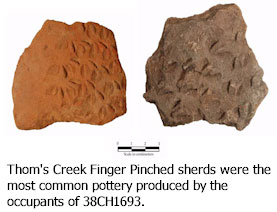 And speaking of garbage,
archaeologists found plenty
of evidence of other things
discarded by these early
occupants of Carolina Park.
The most common item is
broken pottery. The Thom’s
Creek pottery at this site
was primarily undecorated.
The most common surface
treatment, however, was
finger pinched. Made
by pinching the wet clay
between the thumb and
forefinger, the artisan
typically produced linear
arrangements of this design
around the vessel. Other
decorations included finger
smoothed, and punctuated. The
pots were about 13-14 inches
in diameter, although a few
were as small as 6-inches.
Even when these pots were
broken, they were not
necessarily discarded. Some
were actually repaired and
reused. By drilling holes on
each side of the crack, and
lacing the pot together with
sinew, the pieces of the pot
were held together. To make
the pot watertight, or leak
proof, pitch might be
smeared over the break.
Examples of these mending
holes are found in the
38CH1693 collection. And speaking of garbage,
archaeologists found plenty
of evidence of other things
discarded by these early
occupants of Carolina Park.
The most common item is
broken pottery. The Thom’s
Creek pottery at this site
was primarily undecorated.
The most common surface
treatment, however, was
finger pinched. Made
by pinching the wet clay
between the thumb and
forefinger, the artisan
typically produced linear
arrangements of this design
around the vessel. Other
decorations included finger
smoothed, and punctuated. The
pots were about 13-14 inches
in diameter, although a few
were as small as 6-inches.
Even when these pots were
broken, they were not
necessarily discarded. Some
were actually repaired and
reused. By drilling holes on
each side of the crack, and
lacing the pot together with
sinew, the pieces of the pot
were held together. To make
the pot watertight, or leak
proof, pitch might be
smeared over the break.
Examples of these mending
holes are found in the
38CH1693 collection.
When sherds (bits of broken
pottery) were thrown away
they might still be picked
up and used, or recycled, –
most commonly as
abraders or hones.
The Thom’s Creek people used
them to shape and smooth
bone tools. These bones are
thought to have been used to
weave the nets for
collecting small fish. Other
bones were sharpened to make
tips
for spears (the
bow and arrow was not
invented for another 2,000
or so years).
Although a few stone flakes
were found at 38CH1693, no
finished tools were
recovered by archaeologists.
This is probably because the
coast has few sources of
stone, making it a highly
prized and carefully tended
object. Stone points might
be resharpened, but they
wouldn’t often be lost.
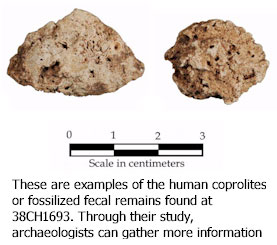 Another interesting find is
what archaeologists call a
coprolites – a fancy
word for
fossilized fecal material.
In a shell-rich environment
the organic matter can be
replaced by calcium, helping
to preserve these remains.
Identified as human based on
size, shape, and contents,
they can be used to better
study exactly what Thom’s
Creek people were eating. Another interesting find is
what archaeologists call a
coprolites – a fancy
word for
fossilized fecal material.
In a shell-rich environment
the organic matter can be
replaced by calcium, helping
to preserve these remains.
Identified as human based on
size, shape, and contents,
they can be used to better
study exactly what Thom’s
Creek people were eating.
Unlike the condensed for
television accounts of
archaeology, the research at
38CH1693 reflects the
reality of archaeology.
After several weeks of
careful but exhausting
excavation, followed by
months of equally
painstaking analysis, we
know a little more about how
the Thom’s Creek people
lived. There is no major
breakthrough or amazing
discovery – just hard work
that gradually builds on
itself to allow us, bit by
bit, to better understand
our ancestry and the history
of South Carolina.
For More Information
-
Read the entire Chicora
report on excavations at
38CH1693
-
Another pdf download is
the 2002 National Park
Service test excavations
at the Fig Island Shell
Ring,
available here.
-
A brief overview of
South Carolina
archaeology is available
here [link to Chicora’s
SC Archaeology page].
-
If your local public
library doesn’t have
these books, you can ask
that they be obtained
for you through
interlibrary loan, a
free service:
|